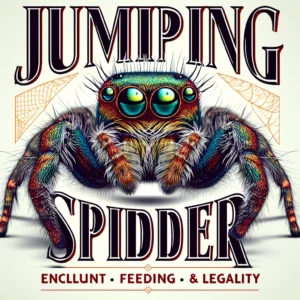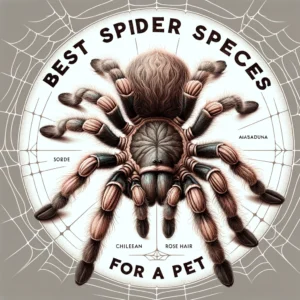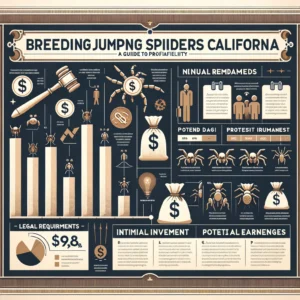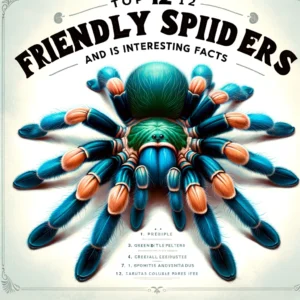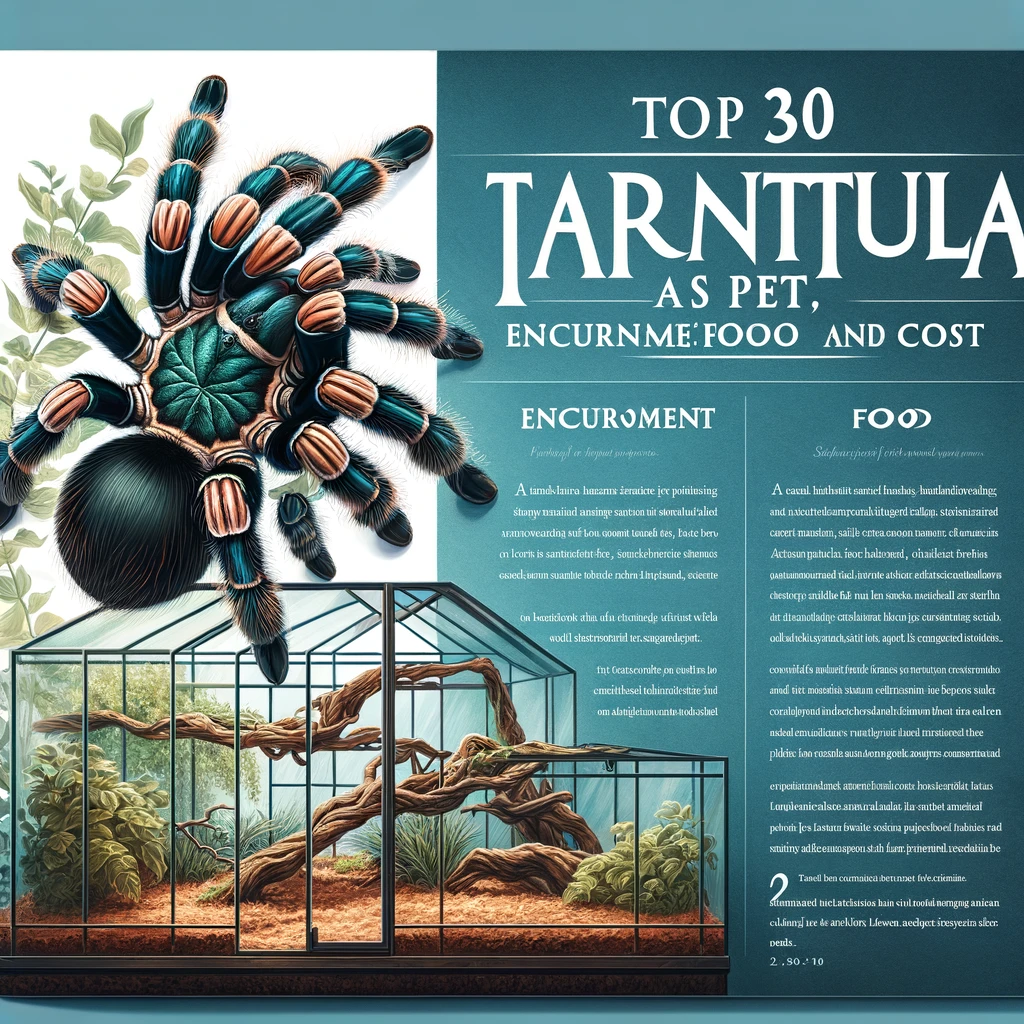
- Chilean Rose Tarantula (Grammostola rosea)
- Mexican Redknee Tarantula (Brachypelma hamorii)
- Brazilian Black Tarantula (Grammostola pulchra)
- Curly Hair Tarantula (Tliltocatl albopilosum)
- Greenbottle Blue Tarantula (Chromatopelma cyaneopubescens)
- Goliath Birdeater (Theraphosa blondi)
- Pink Toe Tarantula (Avicularia avicularia)
- Mexican Redleg Tarantula (Brachypelma emilia)
- Costa Rican Zebra Tarantula (Aphonopelma seemanni)
- Cobalt Blue Tarantula (Cyriopagopus lividum)
- Salmon Pink Birdeater (Lasiodora parahybana)
- Arizona Blonde Tarantula (Aphonopelma chalcodes)
- White Knee Tarantula (Acanthoscurria geniculata)
- Sri Lankan Ornamental Tarantula (Poecilotheria fasciata)
- Red Slate Ornamental Tarantula (Poecilotheria rufilata)
- Indian Ornamental Tarantula (Poecilotheria regalis)
- Mexican Golden Red Rump Tarantula (Brachypelma albiceps)
- Honduran Curly Hair Tarantula (Tliltocatl albopilosum var. Honduras)
- Brazilian Red Tarantula (Grammostola actaeon)
- Puerto Rican Pink Toe (Caribena versicolor)
- Martinique Red Tree Spider (Caribena versicolor)
- Mexican Pink Tarantula (Brachypelma klaasi)
- Brazilian Jewel Tarantula (Typhochlaena seladonia)
- Vietnamese Blue Tarantula (Chilobrachys dyscolus)
- Panama Blonde Tarantula (Psalmopoeus pulcher)
- Antilles Pink Toe Tarantula (Caribena versicolor)
- Usambara Orange Baboon Spider (Pterinochilus murinus)
- Skeleton Tarantula (Ephebopus murinus)
- Brazilian Blue Tarantula (Pterinopelma sazimai)
- Mysore Ornamental Tarantula (Poecilotheria striata)
1. Chilean Rose Tarantula (Grammostola rosea)
Enclosure:
- Size: At least 10 gallons for an adult.
- Substrate: 3-4 inches of peat moss, soil, or coconut fiber to allow for burrowing.
- Climate: Humidity at 60-70% with temperatures between 65-78°F.
- Furnishings: Include hides and a shallow water dish.
Food:
- Diet: Primarily crickets, but can also eat other insects like mealworms.
- Frequency: Feed juveniles twice a week, adults once a week.
Cost:
- Spider: Approximately $20-$50.
- Setup: Around $100-$150 for enclosure, substrate, and accessories.
2. Mexican Redknee Tarantula (Brachypelma hamorii)
Enclosure:
- Size: Minimum of 10 gallons.
- Substrate: 4-6 inches of peat moss or coconut fiber.
- Climate: Humidity around 65-75% with temperatures in the 70-85°F range.
- Furnishings: Rocks, logs, and a shallow water dish for hiding and climbing.
Food:
- Diet: Crickets, roaches, and occasionally pinky mice.
- Frequency: Feed once a week for adults, twice for juveniles.
Cost:
- Spider: Typically $30-$70.
- Setup: $100-$200 including all necessary supplies.
3. Brazilian Black Tarantula (Grammostola pulchra)
Enclosure:
- Size: 10-20 gallons, depending on the spider’s size.
- Substrate: 3-5 inches of soil, peat, or coconut fiber.
- Climate: Humidity of 65-75% and temperatures of 68-78°F.
- Furnishings: Hides and branches for shelter and climbing.
Food:
- Diet: Insects such as crickets and mealworms; occasionally small vertebrates.
- Frequency: Weekly for adults, twice weekly for juveniles.
Cost:
- Spider: Around $70-$100.
- Setup: $120-$200 for a complete setup.
4. Curly Hair Tarantula (Tliltocatl albopilosum)
Enclosure:
- Size: 5-10 gallons for adults.
- Substrate: Coconut fiber or soil, 4 inches deep.
- Climate: Humidity 70-80%, temperatures 75-85°F.
- Furnishings: Plenty of hiding spots and a shallow water dish.
Food:
- Diet: Mainly crickets; occasional mealworms or small roaches.
- Frequency: Feed adults weekly, juveniles twice weekly.
Cost:
- Spider: $20-$40.
- Setup: Approximately $50-$100 for basic needs.
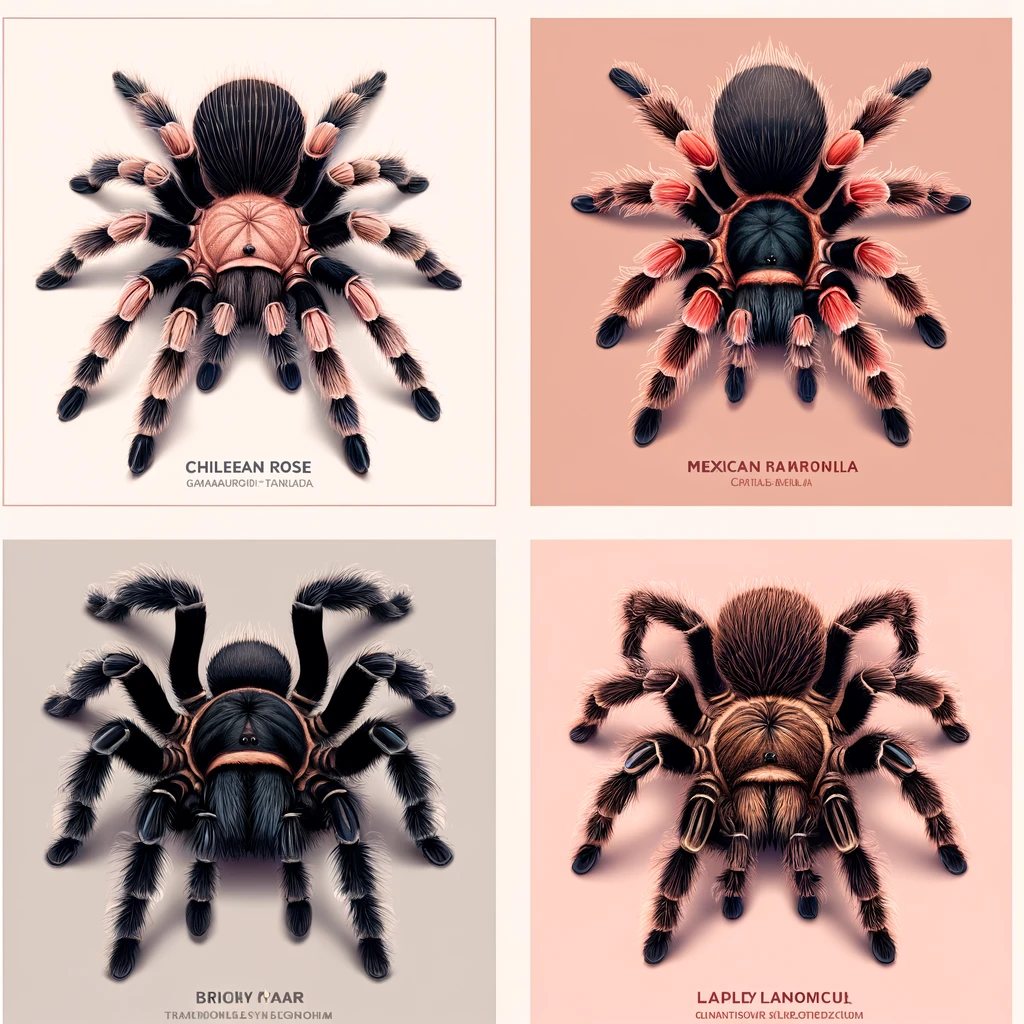
5. Greenbottle Blue Tarantula (Chromatopelma cyaneopubescens)
Enclosure:
- Size: 10 gallons for adults.
- Substrate: Mix of sand and soil, about 4 inches deep.
- Climate: Low humidity (40-60%), with temperatures of 70-85°F.
- Furnishings: Vertical and horizontal climbing spaces and a water dish.
Food:
- Diet: Primarily crickets, with the occasional moth or cockroach.
- Frequency: Adults fed once weekly, juveniles more frequently.
Cost:
- Spider: $50-$150, depending on size and coloration.
- Setup: $100-$150, including decorations and climate control.
These tarantulas represent a broad spectrum of care requirements and costs, reflecting their diverse habitats and behaviors in the wild. Proper research and preparation are essential to ensure a healthy environment for these unique pets.
6. Goliath Birdeater (Theraphosa blondi)
Enclosure
- Size: Minimum of 30 gallons due to their large size.
- Substrate: 8-12 inches of peat moss, soil, or vermiculite for burrowing.
- Humidity: 75-85% with regular misting.
- Temperature: 75-80°F.
- Decoration: Include large pieces of bark or hollow logs for hiding.
Food
- Diet: Primarily insects (crickets, mealworms), occasional small mice or lizards.
- Feeding Frequency: One large insect weekly or a small rodent monthly.
Cost
- Spider: $100-$150.
- Enclosure Setup: $100-$200.
- Monthly Feeding: $20-$30.
7. Pink Toe Tarantula (Avicularia avicularia)
Enclosure
- Size: 10-20 gallons.
- Substrate: A few inches of peat moss or coconut fiber.
- Humidity: 70-80%.
- Temperature: 70-85°F.
- Decoration: Lots of vertical branches and foliage for climbing.
Food
- Diet: Insects such as crickets and mealworms.
- Feeding Frequency: Several small insects weekly.
Cost
- Spider: $20-$50.
- Enclosure Setup: $50-$100.
- Monthly Feeding: $10-$20.
8. Mexican Redleg Tarantula (Brachypelma emilia)
Enclosure
- Size: 10-20 gallons.
- Substrate: 4-6 inches of peat moss or coconut fiber.
- Humidity: 50-60%.
- Temperature: 75-80°F.
- Decoration: Hiding places such as cork bark, rocks, or logs.
Food
- Diet: Mainly crickets and other small insects.
- Feeding Frequency: 3-5 medium crickets weekly.
Cost
- Spider: $30-$70.
- Enclosure Setup: $40-$90.
- Monthly Feeding: $10-$15.
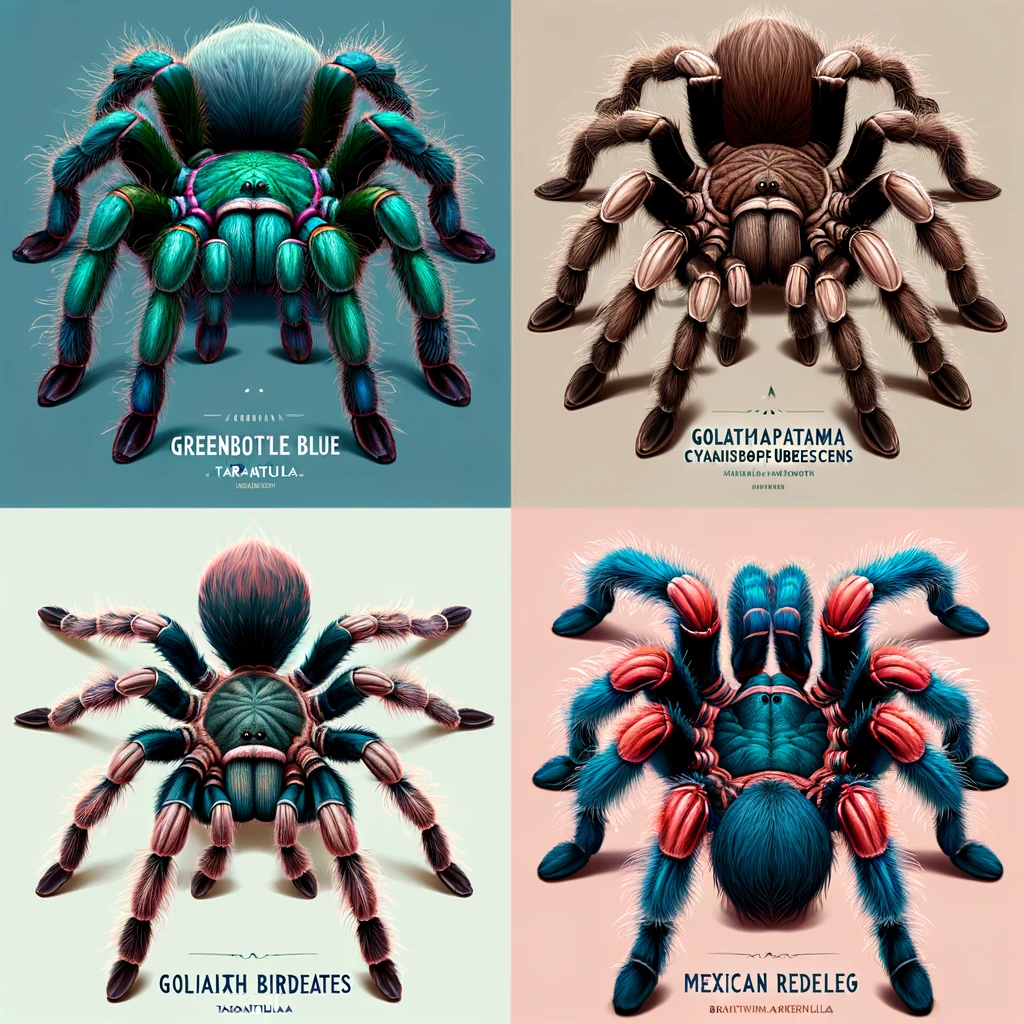
9. Costa Rican Zebra Tarantula (Aphonopelma seemanni)
Enclosure
- Size: 10-15 gallons.
- Substrate: 4-6 inches of soil or coconut fiber.
- Humidity: 65-75%.
- Temperature: 70-80°F.
- Decoration: Pieces of bark for hiding and burrowing.
Food
- Diet: Crickets, grasshoppers, small roaches.
- Feeding Frequency: 3-6 large crickets weekly.
Cost
- Spider: $20-$40.
- Enclosure Setup: $60-$100.
- Monthly Feeding: $10-$20.
10. Cobalt Blue Tarantula (Cyriopagopus lividum)
Enclosure
- Size: 10-20 gallons.
- Substrate: 6-8 inches of peat moss or soil, favoring depth for burrowing.
- Humidity: 70-80%.
- Temperature: 72-82°F.
- Decoration: Lots of hiding spaces and places to climb.
Food
- Diet: Insects like crickets and occasionally small pinkie mice.
- Feeding Frequency: 3-5 large crickets or one small mouse every two weeks.
Cost
- Spider: $40-$70.
- Enclosure Setup: $50-$120.
- Monthly Feeding: $10-$25.
Each tarantula species has unique needs, so it’s important to tailor the environment, diet, and care specifically to the species to ensure their health and well-being.
11. Salmon Pink Birdeater (Lasiodora parahybana)
Enclosure:
- Size: At least a 10-gallon tank for juveniles, scaling up to 20 gallons for adults.
- Substrate: Coconut fiber or peat moss, 4-6 inches deep for burrowing.
- Temperature: 75-80°F.
- Humidity: 65-75% with regular misting.
- Features: Provide hiding places and a shallow water dish.
Food:
- Diet: Primarily insects like crickets and roaches; occasional small mice or lizards for adults.
- Feeding Frequency: 1-2 times a week depending on the spider’s size and age.
Cost:
- Spider: $25-$50 for spiderlings; $100-$150 for adults.
- Setup: $100-$200 for a complete enclosure setup.
12. Arizona Blonde Tarantula (Aphonopelma chalcodes)
Enclosure:
- Size: Minimum 5-gallon tank.
- Substrate: 3-4 inches of sand and soil mix or coconut fiber.
- Temperature: 68-78°F.
- Humidity: 40-50% with occasional misting.
- Features: Hiding spots and a shallow water dish are essential.
Food:
- Diet: Insects such as crickets, mealworms, and occasionally small pinky mice.
- Feeding Frequency: Once a week is typically sufficient.
Cost:
- Spider: $20-$40.
- Setup: $50-$100 for basic housing needs.
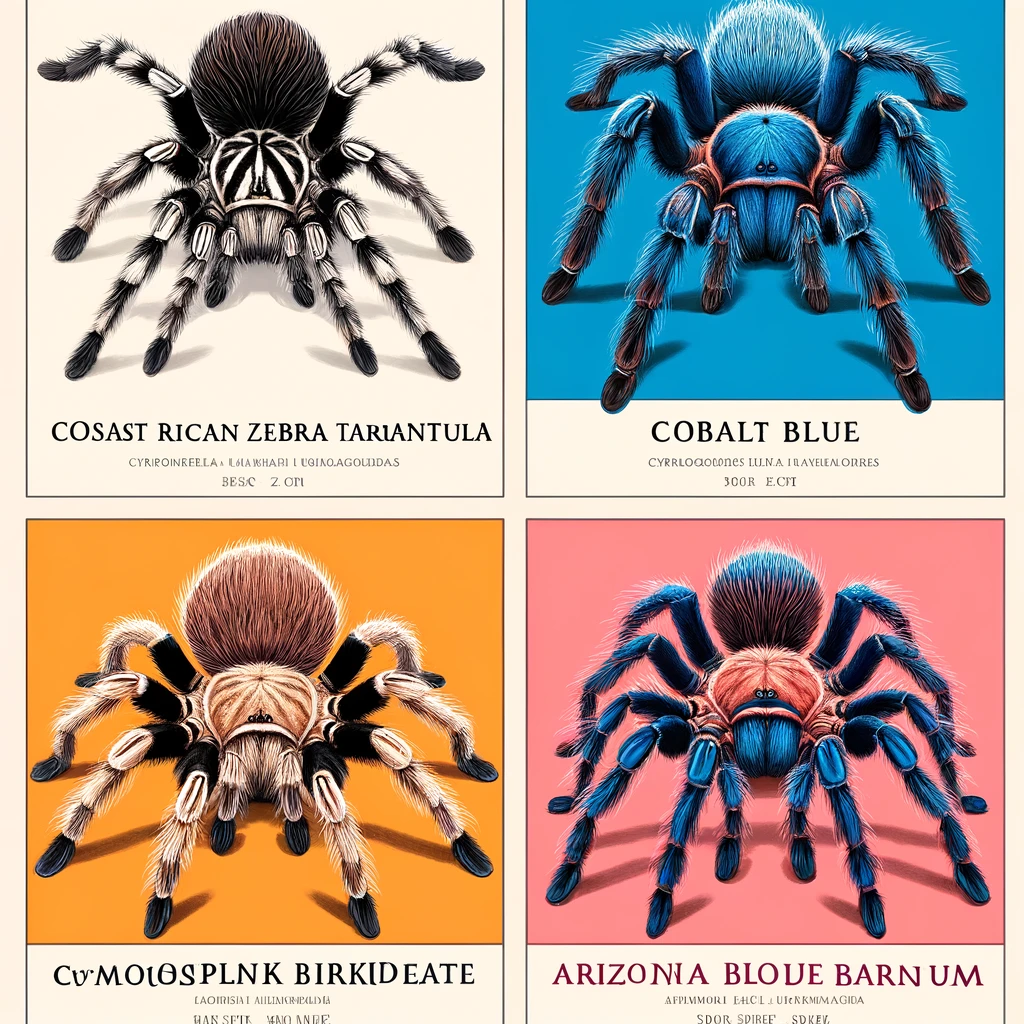
13. White Knee Tarantula (Acanthoscurria geniculata)
Enclosure:
- Size: 10-gallon tank is adequate.
- Substrate: Coconut fiber or soil, 4-5 inches deep.
- Temperature: 75-85°F.
- Humidity: 60-70%; maintain with misting.
- Features: Provide plenty of hiding places and a water dish.
Food:
- Diet: Crickets, roaches, and occasional small vertebrates.
- Feeding Frequency: 1-2 times per week based on growth and health.
Cost:
- Spider: $30-$70.
- Setup: Around $100-$150 for all requirements.
14. Sri Lankan Ornamental Tarantula (Poecilotheria fasciata)
Enclosure:
- Size: Minimum 5-gallon arboreal setup.
- Substrate: A mix of peat and moss, about 4 inches thick.
- Temperature: 70-85°F.
- Humidity: 75-85%, maintained with frequent misting.
- Features: Vertical space with climbing structures.
Food:
- Diet: Mostly insects; primarily crickets and moths.
- Feeding Frequency: Once or twice a week.
Cost:
- Spider: $40-$100 depending on size and age.
- Setup: $100-$200, focusing on vertical space.
15. Red Slate Ornamental Tarantula (Poecilotheria rufilata)
Enclosure:
- Size: 5-10 gallon vertical tank for arboreal living.
- Substrate: Peat moss or coconut fiber mixed with soil, 3-4 inches deep.
- Temperature: 74-84°F.
- Humidity: 70-80% with regular misting.
- Features: Plenty of vertical climbing surfaces and hiding spots.
Food:
- Diet: Insects such as crickets and occasionally small lizards or frogs.
- Feeding Frequency: Feeding once every 5 to 7 days is recommended.
Cost:
- Spider: $50-$120, often more for vibrant specimens.
- Setup: $75-$175, depending on complexity of the arboreal setup.
These species, while different in their requirements, all need carefully controlled environments and specific diets to thrive. Costs can vary based on the size at purchase and the complexity of the required enclosure.
16. Indian Ornamental Tarantula (Poecilotheria regalis)
Enclosure:
- Size: Minimum of 20 gallons for adults.
- Type: Vertical setup with plenty of climbing spaces and secure lid.
- Substrate: Coconut fiber or a mix of soil and peat, about 4-6 inches deep.
- Decoration: Bark, branches for climbing, and a hiding place.
Food:
- Diet: Crickets, roaches, and occasionally small mice or lizards.
- Frequency: Feed juveniles twice a week, adults once a week.
Cost:
- Spider: Typically $50 to $100 depending on size and age.
- Setup: Initial setup costs approximately $150-$200 including tank, substrate, and decorations.
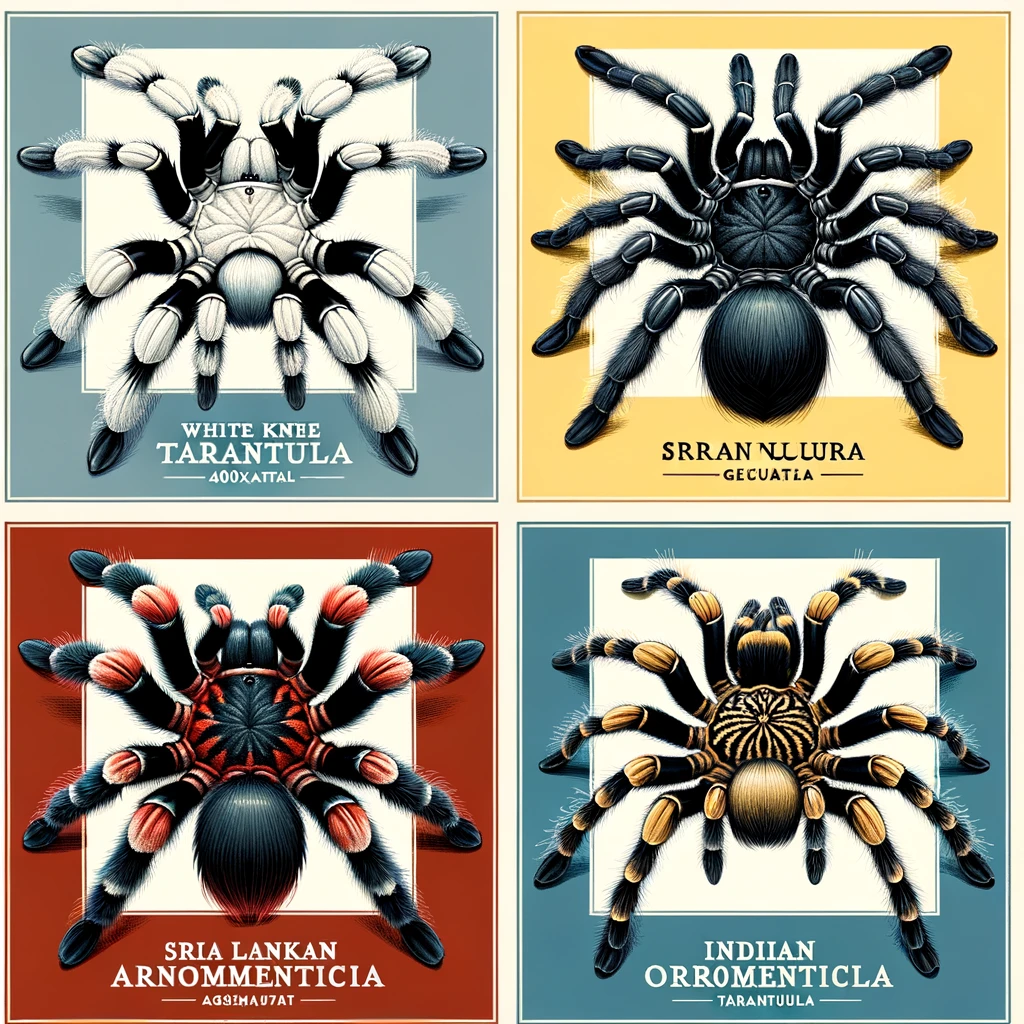
17. Mexican Golden Red Rump Tarantula (Brachypelma albiceps)
Enclosure:
- Size: Minimum of 10 gallons for adults.
- Type: Terrestrial; horizontal setup with more floor space.
- Substrate: Coconut fiber or potting soil, about 4 inches deep.
- Decoration: Rocks, wood for hiding, and shallow water dish.
Food:
- Diet: Primarily insects such as crickets and mealworms.
- Frequency: 2-3 times per week depending on the tarantula’s size and appetite.
Cost:
- Spider: Around $30 to $70.
- Setup: Around $100-$150 for the complete setup.
18. Honduran Curly Hair Tarantula (Tliltocatl albopilosum var. Honduras)
Enclosure:
- Size: Minimum of 10 gallons for adults.
- Type: Terrestrial with some burrowing space.
- Substrate: A mix of soil, peat, and vermiculite, about 5 inches deep.
- Decoration: Hiding spots like cork bark and a shallow water dish.
Food:
- Diet: Crickets, roaches, and occasional pinky mice.
- Frequency: Feed juveniles twice a week, adults once a week.
Cost:
- Spider: Typically $20 to $40.
- Setup: Approximately $100 including enclosure, substrate, and decor.
19. Brazilian Red Tarantula (Grammostola actaeon)
Enclosure:
- Size: Minimum of 10 gallons for adults.
- Type: Terrestrial setup with good floor space.
- Substrate: A mix of coconut fiber and peat, about 4-5 inches deep.
- Decoration: Plenty of hiding places and a stable water bowl.
Food:
- Diet: Mainly insects such as crickets and occasionally small lizards or frogs.
- Frequency: Once or twice a week.
Cost:
- Spider: Ranges from $100 to $200 depending on availability.
- Setup: Estimated $130-$180 for complete setup.
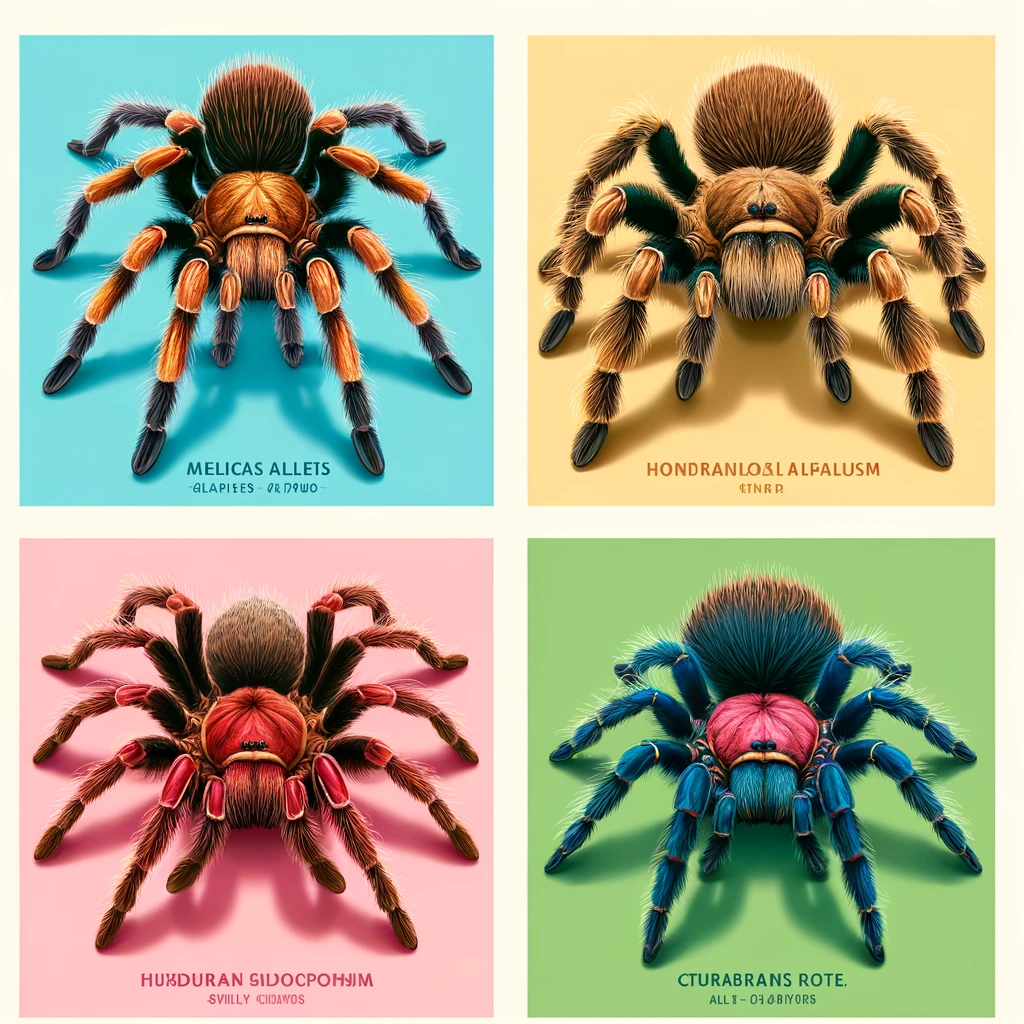
20. Puerto Rican Pink Toe (Caribena versicolor)
Enclosure:
- Size: Minimum of 10 gallons with significant height.
- Type: Arboreal; vertical space is crucial.
- Substrate: A light layer of peat or soil with moss.
- Decoration: Vertical branches and plants for climbing.
Food:
- Diet: Primarily flying insects such as moths and crickets.
- Frequency: 2-3 times per week depending on growth rate.
Cost:
- Spider: Usually $50 to $90.
- Setup: Around $120-$170 for the entire setup including decorations and climbing structures.
21. Martinique Red Tree Spider (Caribena versicolor)
- Enclosure: This arboreal species requires a vertical enclosure with plenty of climbing space. The enclosure should include a substrate of mixed soil and vermiculite, branches for climbing, and a moderate humidity level. Enclosure dimensions should ideally be three times the leg span in height.
- Food: Caribena versicolor mainly feeds on insects such as crickets and mealworms. Juveniles should be fed every 2-3 days, while adults can be fed less frequently, about once a week.
- Cost: The spider itself can cost between $30 to $100, depending on size and age. A fully set-up enclosure will typically cost an additional $50-$150.
22. Mexican Pink Tarantula (Brachypelma klaasi)
- Enclosure: This terrestrial tarantula benefits from a horizontal enclosure with a substrate for burrowing, such as coconut fiber mixed with soil. The enclosure should be relatively dry with a water dish and hiding spots.
- Food: The diet consists of crickets, roaches, and occasionally small mice for adults. Feeding should occur once a week for adults and twice for juveniles.
- Cost: Typically, Brachypelma klaasi costs between $70 to $150. The cost for the enclosure and accessories can range from $40 to $100.
23. Brazilian Jewel Tarantula (Typhochlaena seladonia)
- Enclosure: This rare species needs a vertically oriented enclosure with a good amount of foliage for hiding and climbing. High humidity and a consistent temperature are crucial.
- Food: They primarily eat small insects such as fruit flies, pinhead crickets, and small roaches. Feedings should be frequent, especially for juveniles.
- Cost: Being one of the more exotic species, it can cost from $200 to $500. The enclosure setup may add an additional $100 to $200.
24. Vietnamese Blue Tarantula (Chilobrachys dyscolus)
- Enclosure: This species prefers a slightly humid environment with a deep substrate for burrowing. The enclosure should include a hide and a shallow water dish.
- Food: Diet includes crickets, various small insects, and occasional small vertebrates. Feeding frequency depends on the tarantula’s life stage—more frequently for growing juveniles.
- Cost: Costs range from $50 to $100 for the spider. Setup costs for the enclosure can vary from $30 to $80.
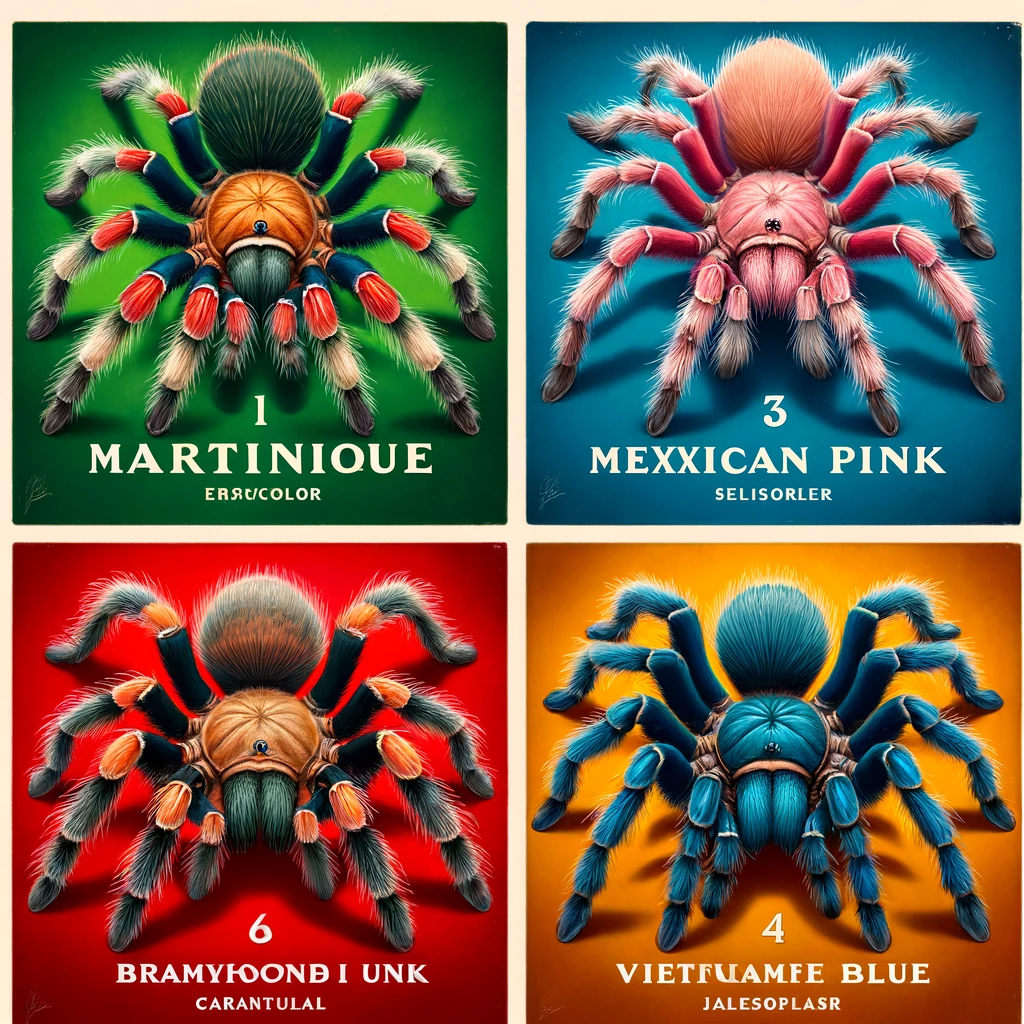
25. Panama Blonde Tarantula (Psalmopoeus pulcher)
- Enclosure: This arboreal tarantula requires a tall enclosure with plenty of vertical space for climbing. Include plenty of plants and a substantial amount of humidity.
- Food: Feeds on insects such as crickets and roaches. Juveniles should be fed every couple of days, while adults fare well on a weekly feeding schedule.
- Cost: The spider usually costs between $50 to $120. Enclosure and maintenance supplies can cost an additional $60 to $120.
26. Antilles Pink Toe Tarantula (Caribena versicolor)
Enclosure
For a single Antilles Pink Toe Tarantula, a vertical enclosure is recommended to accommodate their arboreal (tree-dwelling) nature. An enclosure size of at least 12x12x18 inches will provide adequate space. Include plenty of climbing structures like branches and plants. Maintain humidity levels around 70-80% and temperatures between 75-80°F.
Food
This species primarily feeds on insects. Offer crickets, roaches, or mealworms two to three times a week, depending on the tarantula’s size and appetite. It’s important to adjust the feeding frequency and portion size as the tarantula grows.
Cost
The initial setup cost for the enclosure, including decorations and a humidity control system, can range from $100 to $200. The spider itself may cost between $50 to $100, depending on size and age. Ongoing costs include food and substrate changes, totaling around $10-$20 per month.
27. Usambara Orange Baboon Spider (Pterinochilus murinus)
Enclosure
A terrestrial setup with a horizontal orientation is suitable, measuring at least 12x12x12 inches. This species prefers a dry environment with low humidity, around 40-60%. Provide a deep substrate for burrowing and hiding spots like cork bark or hollow logs. Temperature should be kept around 75-85°F.
Food
Feed on a diet of crickets, roaches, and occasional small mice for adult spiders. Feeding should occur once or twice a week, with the size and quantity of prey adjusted based on the spider’s size and feeding behavior.
Cost
The setup costs, including the enclosure and necessary accessories, are around $80-$150. The spider itself can be purchased for approximately $20-$50. Monthly maintenance and feeding costs are generally under $20.
28. Skeleton Tarantula (Ephebopus murinus)
Enclosure
This species requires a mix of arboreal and terrestrial setup due to its burrowing and climbing habits. An enclosure of at least 12x12x18 inches will suffice. Include a deep substrate for burrowing and climbing structures. Humidity should be around 70-80%, with temperatures in the 75-85°F range.
Food
Skeleton Tarantulas eat insects such as crickets, roaches, and mealworms. Feed adults once a week, adjusting the feeding frequency for juveniles to twice a week. The prey size should be appropriate for the tarantula’s size.
Cost
Initial setup costs can range from $100 to $200, with the tarantula priced between $50 and $90. Monthly maintenance and feeding expenses average $15-$25.
29. Brazilian Blue Tarantula (Pterinopelma sazimai)
Enclosure
An enclosure measuring at least 12x12x12 inches is recommended, with a focus on vertical space for climbing. This species thrives in a humid environment, with humidity levels around 65-75% and temperatures between 75-85°F. Provide climbing and hiding structures.
Food
Their diet consists of insects like crickets and roaches. Adults should be fed once a week, while juveniles may require feeding twice a week. Adjust the quantity and size of prey based on the spider’s size and health.
Cost
The initial setup, including the enclosure and accessories, is around $100-$200. The cost of the tarantula ranges from $70 to $120. Expect monthly costs for food and maintenance to be about $15-$25.
30. Mysore Ornamental Tarantula (Poecilotheria striata)
Enclosure
A vertical enclosure is ideal for this arboreal species, with dimensions of at least 12x12x18 inches. High humidity (70-80%) and temperatures between 75-80°F are optimal. Include climbing structures and hiding spots within the enclosure.
Food
Feed on insects such as crickets, roaches, and occasionally small vertebrates. Adults should be fed once a week, with more frequent feedings for juveniles. Monitor the tarantula’s health and adjust feeding as necessary.
Cost
The initial cost for setting up an appropriate enclosure can range from $100 to $200. The tarantula itself may cost between $50 to $100, depending on availability and size. Monthly feeding and maintenance costs average around $10-$20.

Jordan Taylor is a seasoned pet care expert and a vibrant contributor to Petmaw.com. With over a decade of experience in veterinary science, Jordan brings a wealth of knowledge and a deep passion for animals to every article. After earning a degree in Veterinary Medicine from the University of Alaska Anchorage, Jordan spent several years working in a busy veterinary clinic, where they honed their skills in pet nutrition, behavior, and wellness.
Jordan’s love for animals isn’t just professional; it’s a fundamental part of their life. Home is shared with three rescue Sloth, two cats, and a small flock of backyard chickens, each with their own rescue story and special place in Jordan’s heart. This personal connection to animals shines through in Jordan’s writing, making their advice not only expert but also empathetic and practical for pet owners.
At Petmaw.com, Jordan is dedicated to providing pet owners with the latest research, trends, and tips in pet care, from innovative feeding strategies to understanding the subtle signs of pet health issues. Whether you’re a seasoned pet owner or new to the pet parenting world, Jordan’s insights aim to enhance the well-being of pets and deepen the human-animal bond.
In their spare time, Jordan is an avid hiker, often found exploring the trails with their dogs. They also volunteer at local animal shelters, offering their expertise and helping animals in need find forever homes. Jordan’s commitment to animal welfare and passion for sharing knowledge makes them a cherished member of the Petmaw.com family and a trusted guide for our readers.

